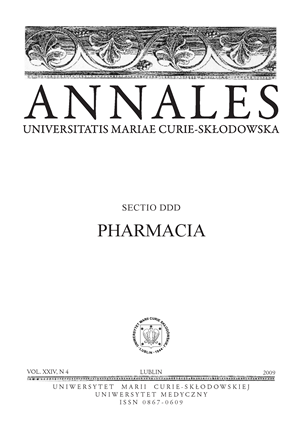Aktywność anidulafunginy w stosunku do szczepów Candida albicans izolowanych z materiałów klinicznych
Abstrakt
Infekcje wywoływane przez C. albicans są ważnym problemem medycznym u osób z grup ryzyka, głównie pacjentów szpitali. Celem pracy była ocena wrażliwości klinicznych szczepów C . albicans na anidulafunginę metodą E-testów. Lek ten jest przedstawicielem nowej grupy antybiotyków przeciwgrzybiczych – echinokandin. Uzyskane dane świadczą o tym, że wszystkie szczepy C. albicans izolowane z materiałów klinicznych były wrażliwe na anidulafunginę. Nasze dane oraz dane literatury potwierdzają zasadność wpisania anidulafunginy na listę leków skutecznych w zakażeniach wywołanych przez drożdżaki, w tym C. albicans. Ponadto metoda E-testów może być stosowana w rutynowym oznaczaniu wrażliwości Candida spp. na anidulafunginę.
Bibliografia
1. Arevalo M. P. et al.: Antifungal activity of the echinocandin anidulafungin (VER002, LY-303366) against yeast pathogens: a comparative study with M27-A microdilution method. J. Antimicrob. Chemother., 51, 163, 2003.
2. Bachmann S. P. et al.: In vitro activity of caspofungin against Candida albicans biofilms. Antimicrob. Agents Chemother., 46 (11), 3591, 2002.
3. Cappellet ty D. M., Jung R.: Anidulafungin and its role in Candida infections. Infect. Drug Resist., 2, 51, 2009.
4. Damle B. et al.: Pharmacokinetics and tissue distribution of anidulafungin in rats. Antimicrob. Agents Chemother., 52 (7), 2673, 2008.
5. Gumbo T. et al.: Anidulafungin pharmacokinetics and microbial response in neutropenic mice with disseminated candidiasis. Antimicrob. Agents Chemother., 50 (11), 3695, 2006.
6. Hof H., Dietz A.: Antifungal activity of anidulafungin, a product of Aspergillus nidulans, against Aspergillus nidulans. Int. J. Antimicrob. Agents, 33, 285, 2009.
7. Jacobson M. J. et al.: In vitro activity of anidulafungin against Candida albicans biofilms. Antimicrob. Agents Chemother., 52 (6), 2242, 2008.
8. Karlowsky J. A. et al.: In vitro interactions of anidulafungin with azole antifungals, amphotericin B and 5-fluorocytosine against Candida species. Int. J. Antimicrob. Agents, 27, 174, 2006.
9. Kett D.H., Cubi l los F.: Anidulafungin in the treatment of patients with invasive candidiasis. Int. J. Antimicrob. Agents, 32 (2), 99, 2008.
10. Pfaller M. A. et al.: Effectiveness of anidulafungin in eradicating Candida species in invasive candidiasis. Antimicrob. Agents Chemother., 49 (11), 4795, 2005.
11. Pfaller M. A. et al.: In vitro activities of anidulafungin against more than 2,500 clinical isolates of Candida spp., including 315 isolates resistant to fluconazole. J. Clin. Microb., 43 (11), 5425, 2005.
12. Roling E. E. et al.: Antifungal activities of fluconazole, caspofungin (MK0991), and anidulafungin (LY 303366) alone and in combination against Candida spp. and Cryptococcus neoformans via time-kill methods. Diagn. Microbiol. Infect. Dis., 43, 13, 2002.
13. Vazquez J. A.: Anidulafungin: a new echinocandin with a novel profile. Clin. Ther., 27 (6), 657, 2005.
Pobrania
Opublikowane
Numer
Dział
Licencja
Prawa autorskie (c) 2009 Autorzy

Praca jest udostępniana na licencji Creative Commons Attribution-NonCommercial-NoDerivatives 3.0 Unported License.


